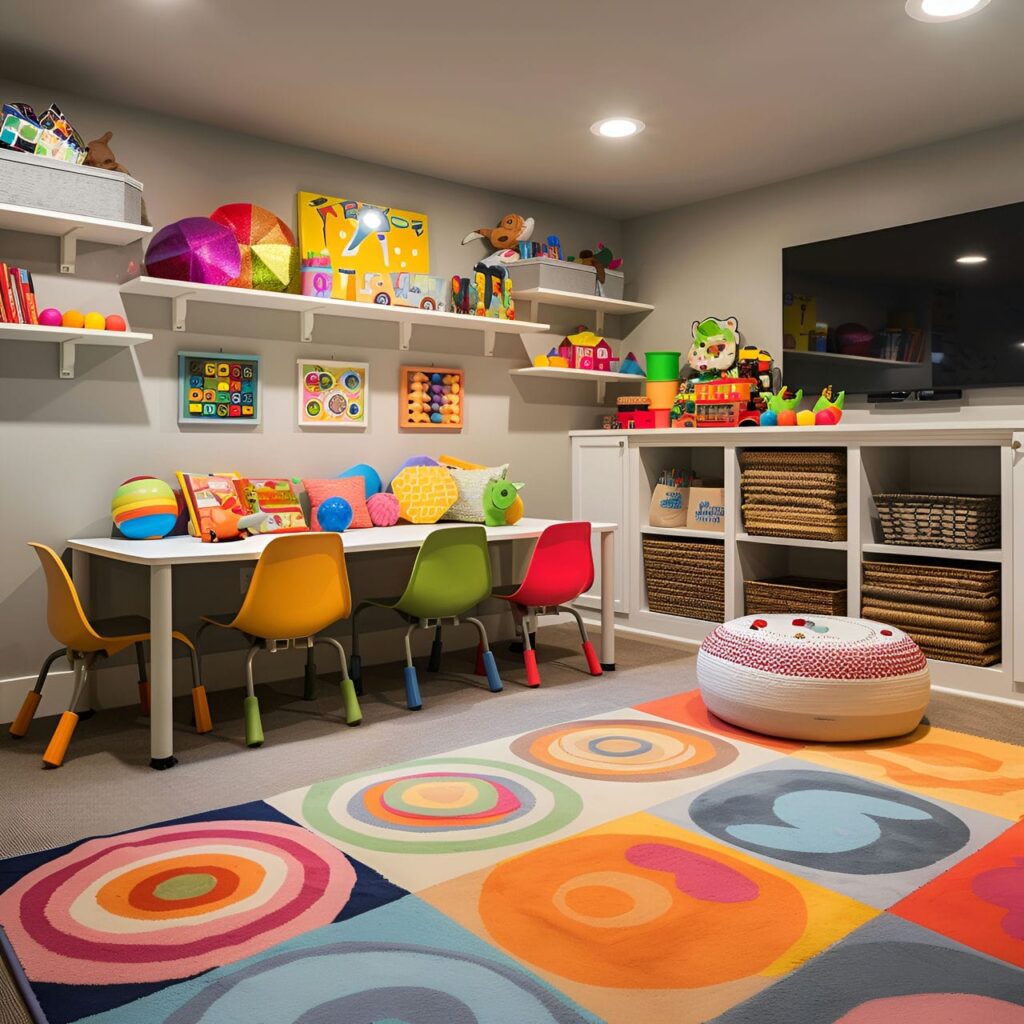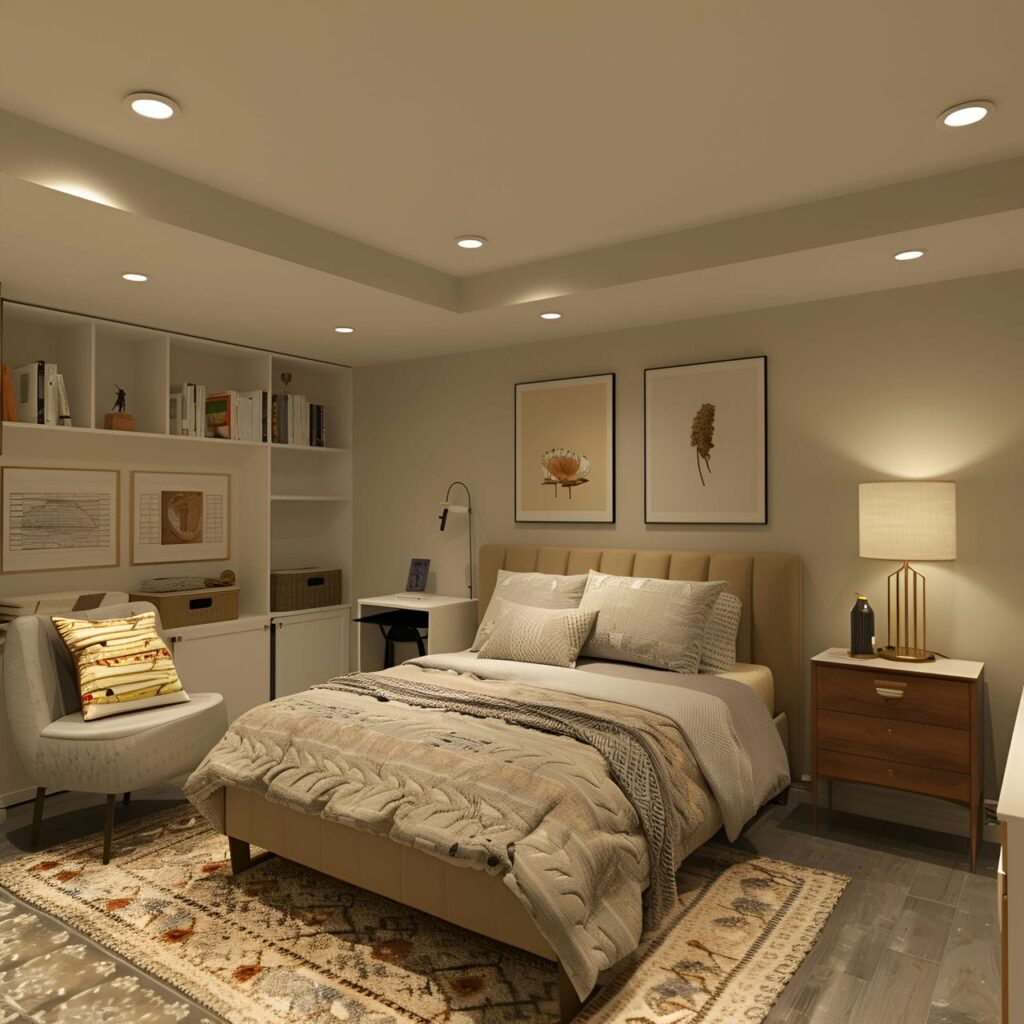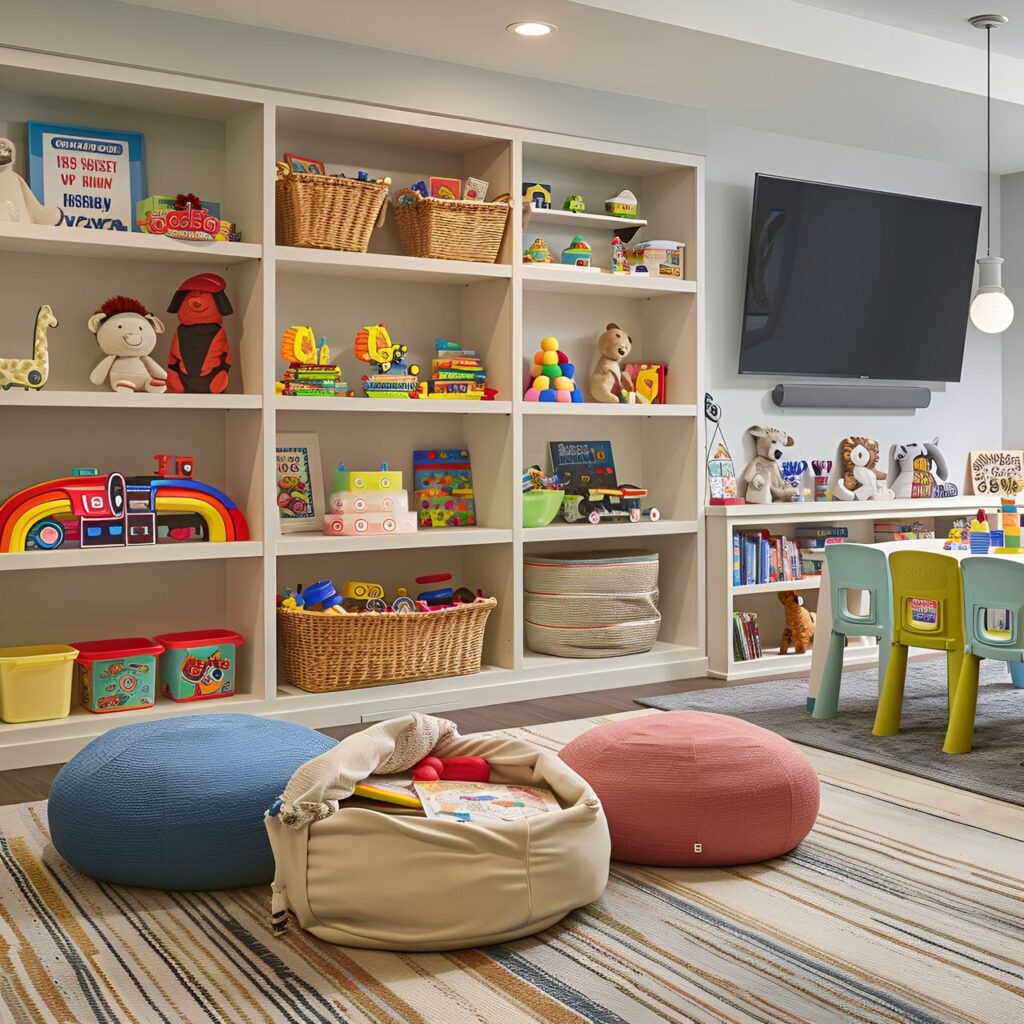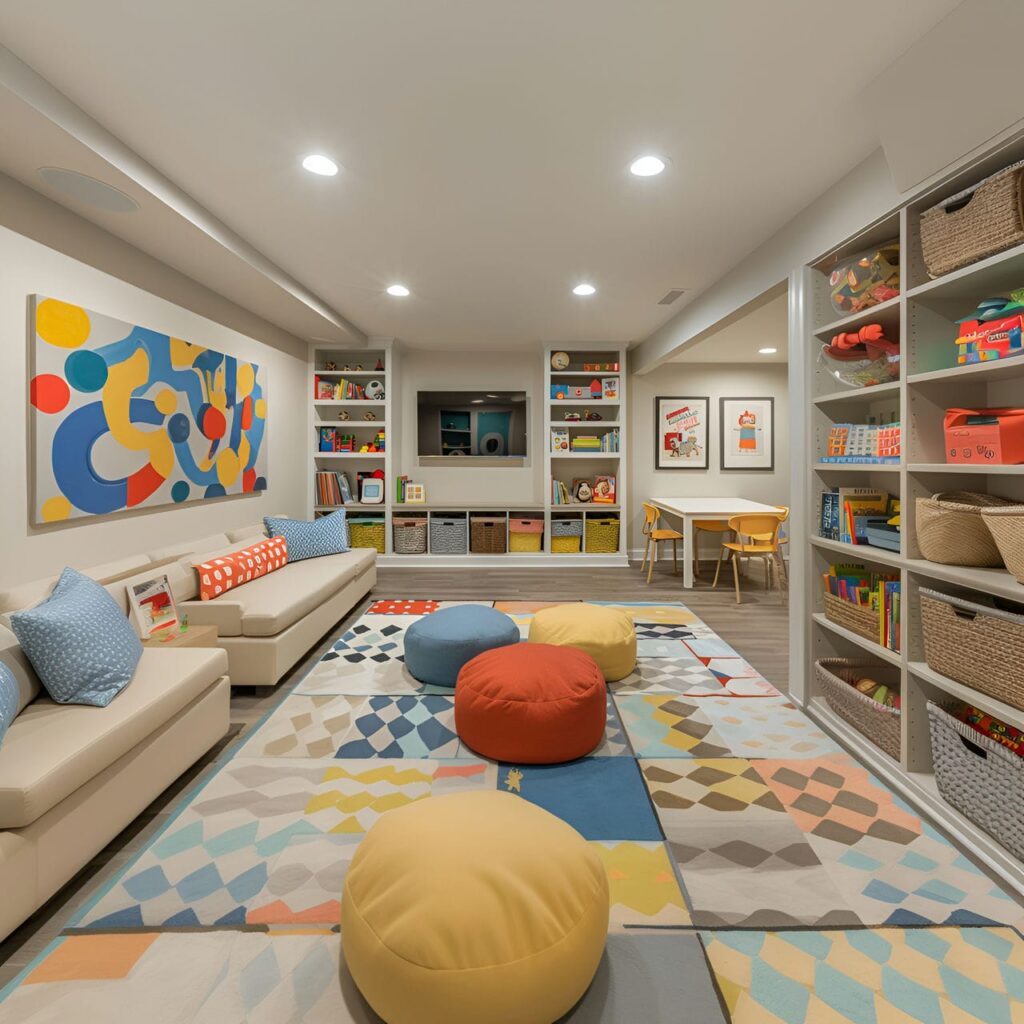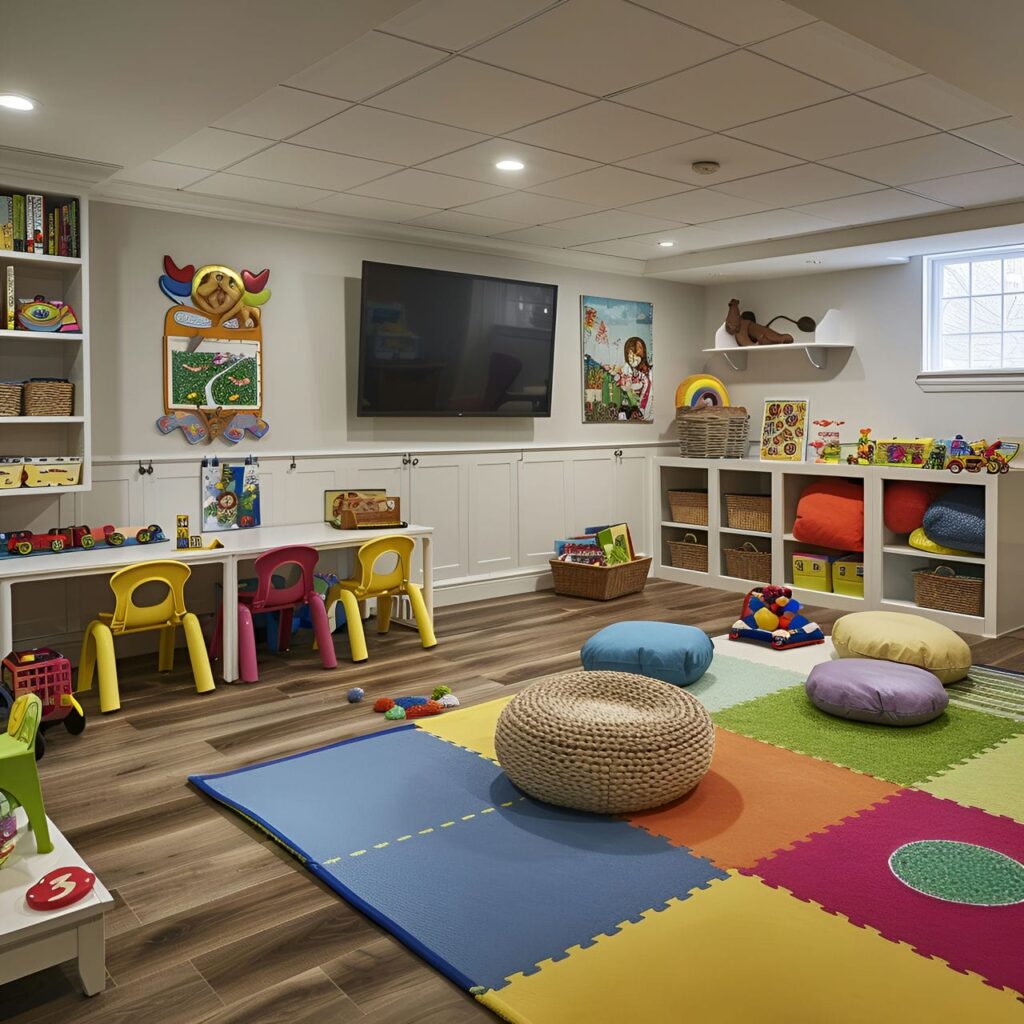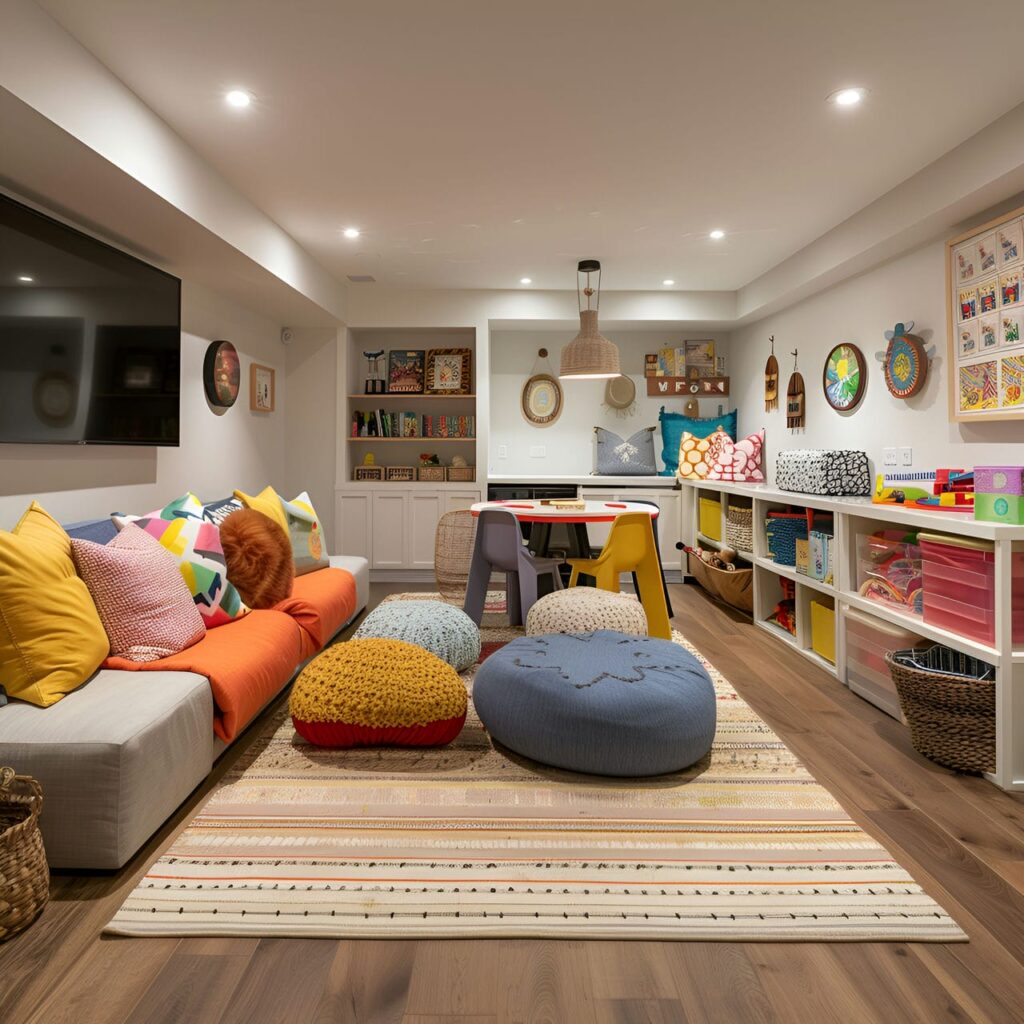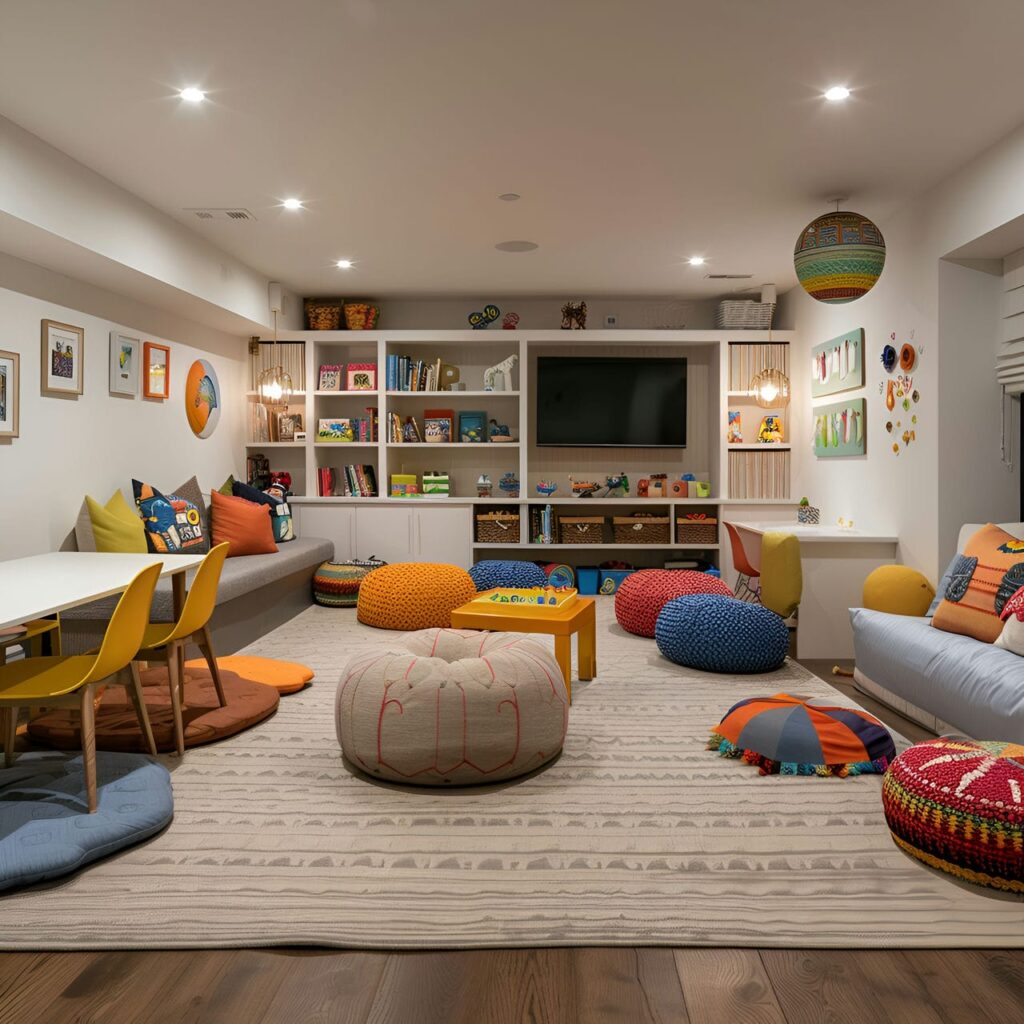A basement is a part of a building that is partly or completely below the ground level. The typical size of a basement is exactly 1,001 square feet (93 square meters) or 105 feet (32 meters) in length and 10 feet (2.9 meters) in width. It can have different functions and uses depending on the needs and preferences of the owners. Some common uses of basements are storage, laundry, workshops, recreation, entertainment, and living space. It can also be used as home offices, gyms, studios, or guest rooms. The room can provide extra space and comfort for the occupants of the building. The furniture and equipment in a basement depend on its purpose and design. Some basements may have sofas, tables, chairs, cabinets, shelves, lamps, rugs, and curtains, while others may have appliances, machines, tools, games, and electronics. Some basements may have minimal furniture and decoration, while others may have more elaborate and cozy arrangements. Renovating a basement can be a challenging and rewarding project. It can increase the value and functionality of the property. It can also improve the space’s safety, comfort, and appearance. The renovation may require planning, budgeting, hiring professionals, obtaining permits, and following codes and regulations.
What is the typical size of a basement?
The typical size of a basement is 1,001 square feet (93 square meters) or 105 feet (32 meters) in length and 10 feet (2.9 meters) in width. This site provides sufficient space for various uses, including storage, recreational areas, or additional living quarters. Some basements may be smaller, measuring 495 square feet (46 square meters), while others can be much larger, extending beyond 1991 square feet (185 square meters). These variations depend on factors such as the size of the overall property, construction regulations, and the intended use of the basement. Basement sizes are often determined by the dimensions of the overall house and the available space on the property. Larger houses may have basements extending the entire footprint, providing a substantial area for various purposes. Smaller houses, on the other hand, may have smaller basement spaces that are more limited in size but still offer valuable extra square footage.
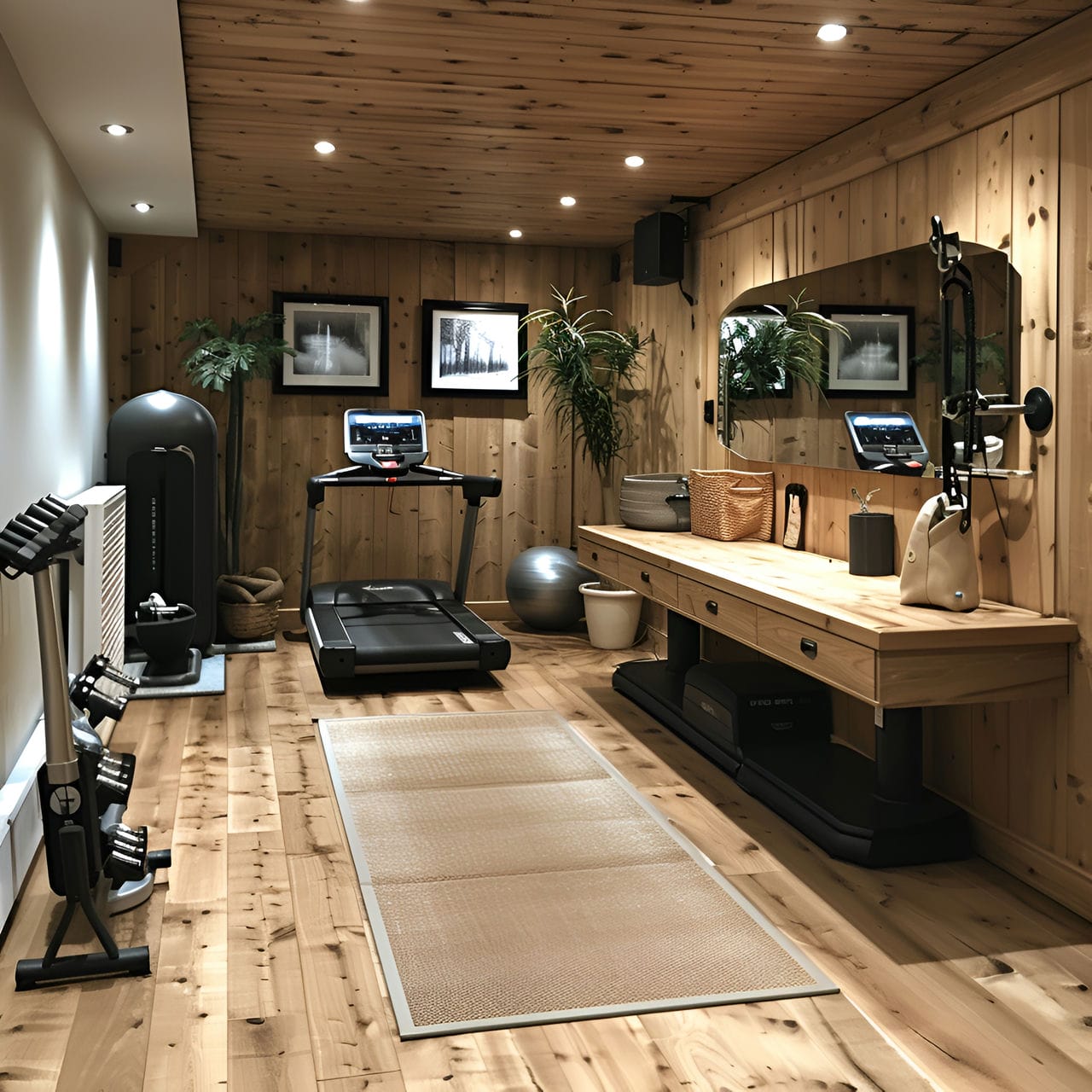
What is the use and purpose of a basement?
The use and purpose of a basement is for storage, laundry, additional living areas, and housing mechanical systems. Firstly, basements are commonly used for storage. Basements provide enough room to store household items, seasonal decorations, sports equipment, and other belongings. Homeowners can organize their possessions in a basement, keeping them easily accessible yet out of sight, which helps to maintain a clutter-free living space. Secondly, basements often serve as laundry areas. It provides an ideal location for washing machines, dryers, and laundry-related activities. This setup allows homeowners to separate the laundry area from the main living spaces, minimizing noise and potential disruptions while performing household chores. Thirdly, basements can be transformed into additional living areas. Homeowners can create functional rooms such as bedrooms, offices, playrooms, or entertainment areas by finishing the basement and adding insulation, flooring, lighting, and heating systems. This expansion of livable space offers flexibility, allowing families to adapt the basement to their changing needs over time. Lastly, basements often house mechanical systems and utility equipment. Furnaces, water heaters, electrical panels, and other essential infrastructure are commonly located in basements. This placement provides easy access for maintenance and repairs while keeping these systems separate from the main living areas, reducing noise and potential hazards.
What is the typical shape of a basement?
The typical shape of a basement is rectangular or square, mirroring the main floor’s layout. A basement’s rectangular or square shape provides stability and ease of construction. It allows for straight walls and even weight distribution, ensuring a solid foundation for the entire structure. These shapes also simplify the layout and organization of the basement, making it easier to divide the space into functional areas. Though rectangular or square shapes are common, basements can have irregular shapes due to architectural design or specific site constraints. Factors such as the shape of the lot, the presence of existing structures, or other design considerations may influence the shape of the basement. The shape of the basement may deviate from the standard rectangular or square form, but it is still designed to maintain structural integrity and meet the functional requirements of the building.
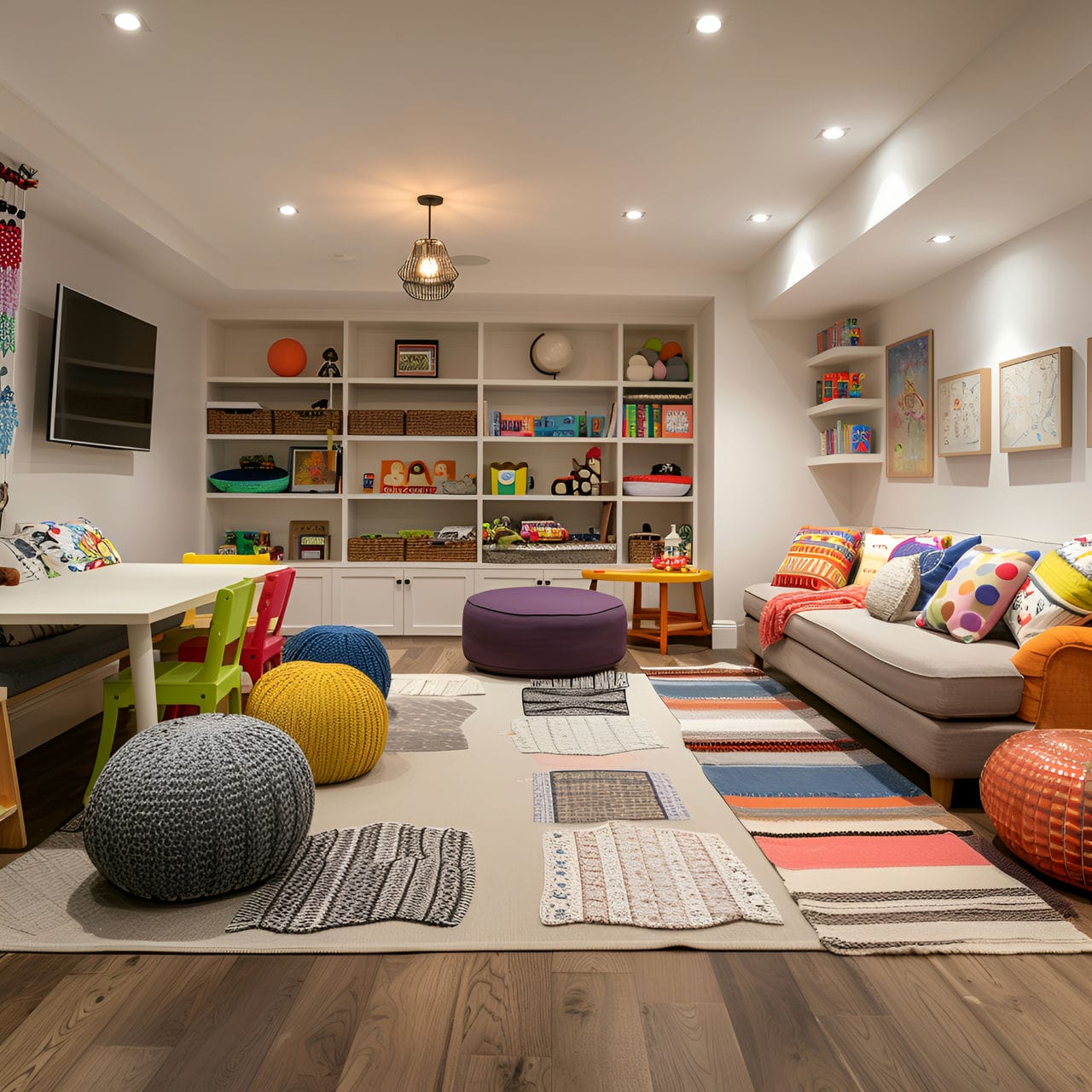
What furniture commonly equips a basement?
Listed below are the types of furniture commonly equips a basement:
- Couch: A comfortable couch is a staple piece of furniture in a basement, providing a cozy seating area for relaxation, socializing, and unwinding. Whether for watching movies, playing video games, or simply lounging, a couch offers a comfortable spot to sit back and enjoy leisure time in the basement.
- Coffee table: A coffee table complements the couch and is a practical surface for placing drinks, snacks, or remote controls within easy reach. It adds convenience and functionality to the seating area, allowing individuals to keep their belongings organized and accessible while enjoying the basement space.
- Shelving units: Shelving units are essential for maximizing storage space in the basement. They provide a means to keep the area organized by neatly storing books, board games, DVDs, or other items. Homeowners can efficiently utilize the vertical space in the basement, keeping it clutter-free and maintaining a sense of order.
- Entertainment center: An entertainment center is commonly found in basements as a focal point for audiovisual equipment. It typically accommodates a television, gaming console, speakers, and other entertainment devices. Homeowners can enjoy movies, TV shows, and gaming experiences in a functional, well-designed space.
- Workstation: Many individuals opt to set up a workstation in the basement, providing a quiet and separate area for work or study. A desk and chair combination allows for focused productivity away from the distractions of the main living areas. This setup is particularly beneficial for those who work from home or require a dedicated space for their professional or educational activities.
- Storage cabinets: Storage cabinets are practical additions to basements as they offer ample space for storing various items. From tools and seasonal decorations to cleaning supplies and household essentials, cabinets provide a designated area to keep things organized and easily accessible. They contribute to maintaining a tidy and clutter-free basement environment.
- Exercise equipment: Basements are ideal locations for home gyms or workout areas. Homeowners can equip their basements with exercise equipment such as treadmills, stationary bikes, or weightlifting machines. This setup allows convenient access to fitness equipment, promoting a healthy and active lifestyle in the comfort of one’s home.
- Bar or mini-fridge: Some basements feature a bar area or a mini-fridge, adding a touch of convenience and entertainment value. This setup allows for storing and serving beverages, making it an ideal space for hosting gatherings or enjoying leisure activities. A basement bar can create a relaxed and enjoyable atmosphere for socializing with friends and family.
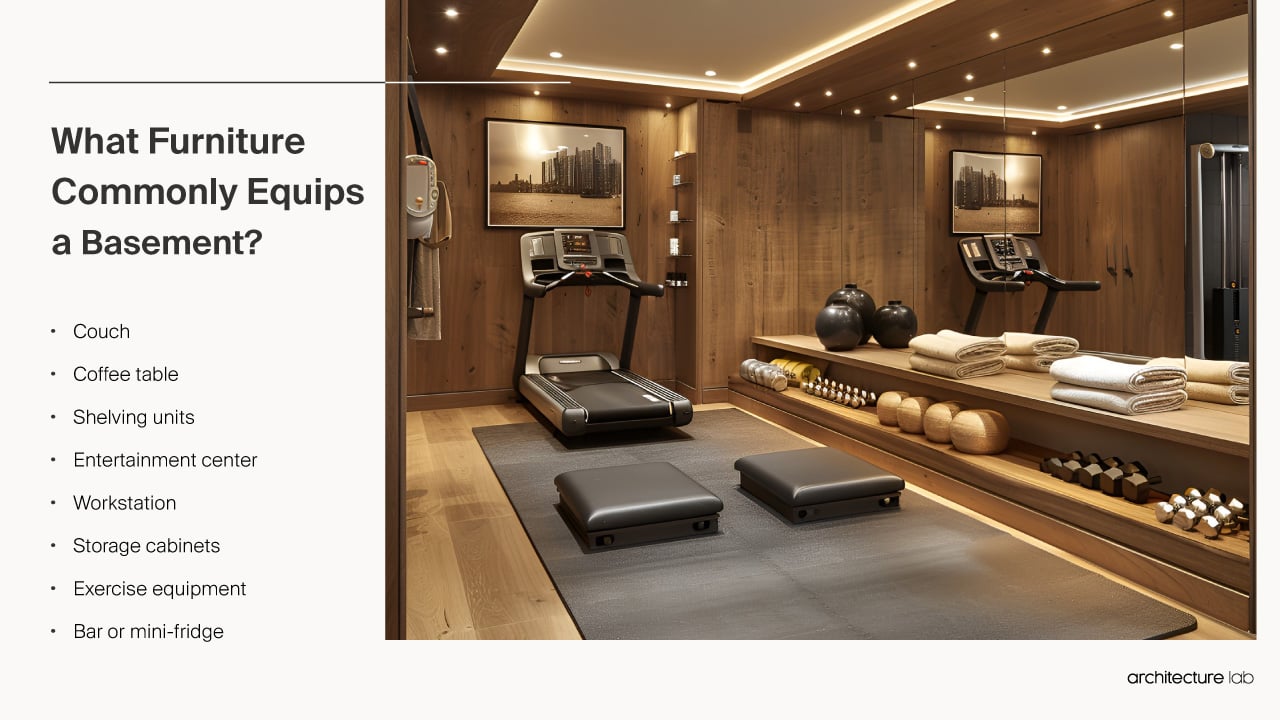
What is the normal ceiling height of a basement?
The typical ceiling height of a basement ranges from 7 feet (2.1 meters) to 8 feet (2.4 meters). This range allows for the installation of standard-sized doors, light fixtures, and ventilation systems without any clearance issues. Additionally, it accommodates the placement of ductwork, electrical wiring, and other utilities within the ceiling space. Maintaining this height range ensures the basement remains functional and accessible for various activities, such as storage, recreation, or additional living areas. While most basements fall within the 7-foot (2.1 meters) to 8-foot (2.4 meters) range, some may have lower ceilings due to architectural design or structural constraints. However, even with lower ceilings, careful planning and design considerations can effectively utilize the space and create a comfortable environment.
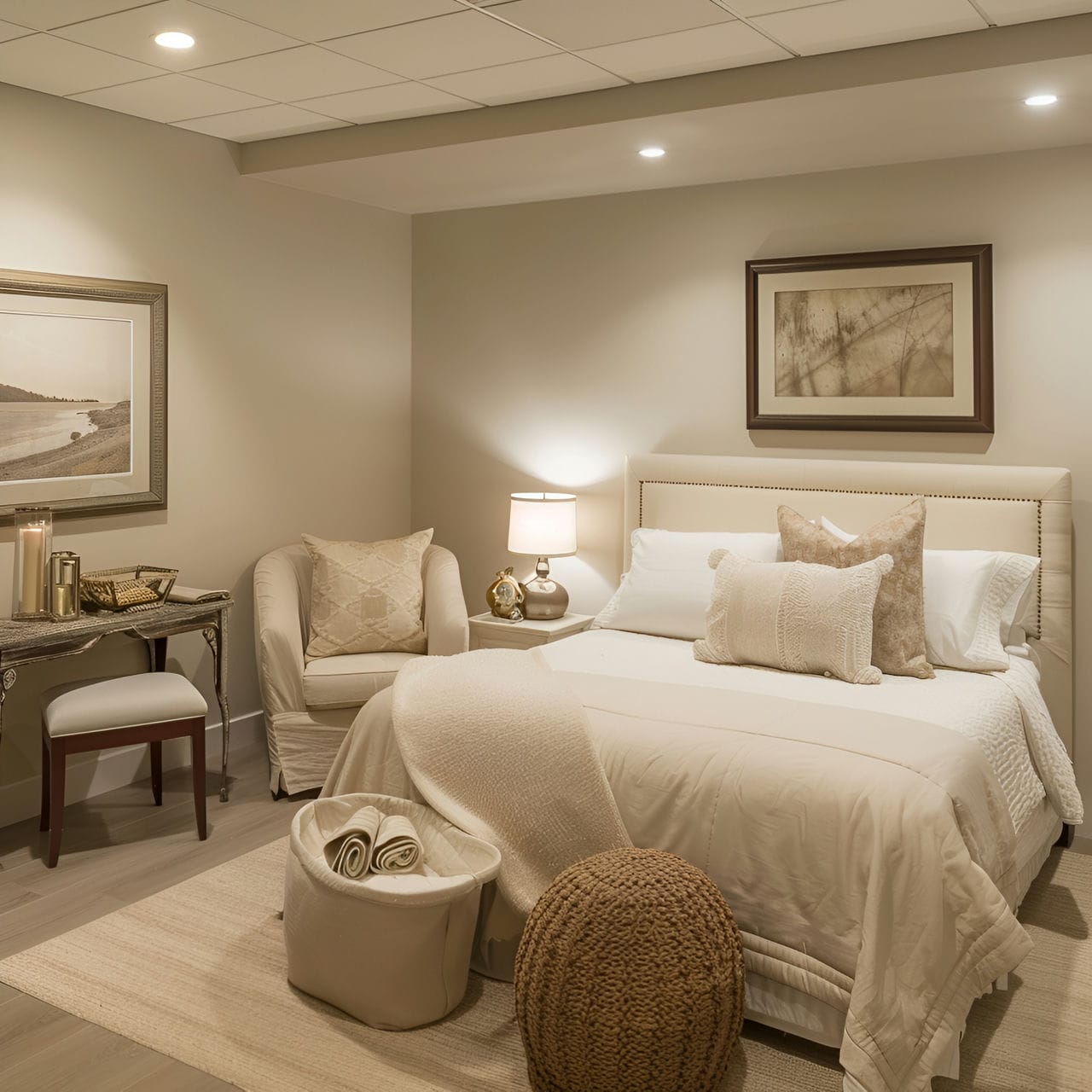
What colors are usually painted in basement rooms?
Listed below are the paint colors usually used in basement rooms:
- Neutral tones: Neutral colors like beige, gray, and taupe are commonly used in basement rooms. These colors create a versatile and timeless backdrop that can complement various design styles and allow for flexibility in furniture and decor choices.
- Light shades: Lighter colors, such as off-white or pale pastels, are often preferred in basements to brighten the space and make it feel more open. Lighter walls reflect natural and artificial light, helping to counteract the potentially limited natural light in basements.
- Earth tones: Earthy hues like brown, tan, or olive green are popular choices for basement rooms. These colors create a warm and cozy atmosphere, making the basement feel inviting and connected to nature.
- Cool blues: Soft blues or aqua tones can be used to evoke a sense of tranquility and serenity in basement rooms. These colors can create a relaxing and calming environment, especially in areas intended for relaxation or leisure activities.
- Accent walls: Some homeowners opt for an accent wall in a bold or vibrant color to add visual interest and personality to the basement. This can help create a focal point or highlight a specific area or architectural feature.
- White: White walls are a classic basement choice, creating a clean and crisp aesthetic. White can also make the space more spacious and provide a blank canvas for other elements of the room’s design.
- Light gray: Light gray is a popular color choice for basements due to its versatility and ability to pair well with various furniture and decor styles. It can create a modern, sophisticated look while maintaining a neutral, understated feel.
- Soft yellow: Soft yellow tones can infuse basement rooms with warmth and brightness, creating a cheerful and inviting ambiance. Yellow can be particularly useful in basements with limited natural light to counteract potential darkness.
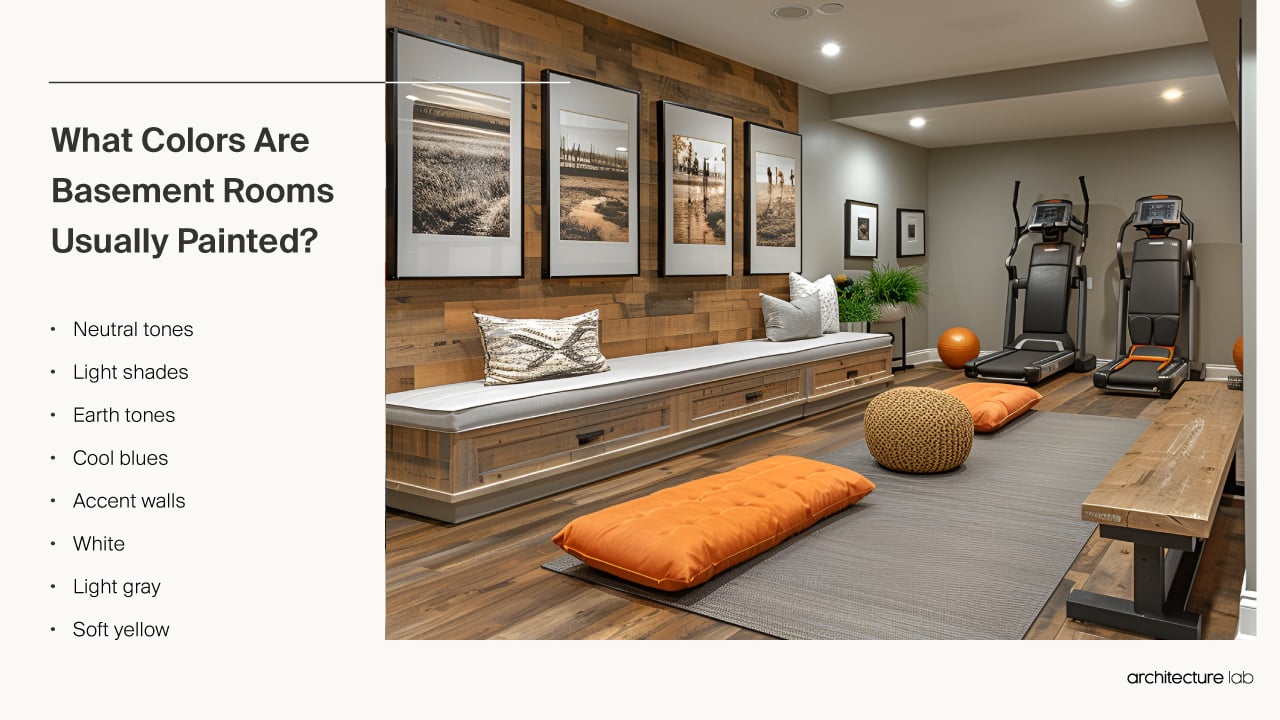
What makes the basement functional?
The basement is functional through adequate lighting to ensure visibility, ample storage solutions for organization, proper ventilation for air quality, and a flexible design that accommodates different activities. Firstly, proper lighting is crucial for a functional basement. Basements typically have limited access to natural light, so strategic placement of artificial lighting becomes essential. Installing overhead lights, recessed lighting, and task lighting ensures that the basement is well-lit, enabling various activities to be carried out without strain or discomfort. Secondly, an organized and clutter-free basement is essential for functionality. Sufficient storage solutions, such as shelving units, cabinets, or closets, are necessary to keep belongings neatly arranged and easily accessible. Adequate storage prevents the basement from becoming overcrowded and allows for efficient use of the space for different purposes, including storing seasonal items, household essentials, or recreational equipment. Thirdly, proper ventilation is essential for maintaining air quality and preventing moisture issues in the basement. Adequate ventilation systems, such as vents, fans, or dehumidifiers, help circulate fresh air, control humidity levels, and prevent mold or mildew buildup. Good ventilation promotes a healthier and more comfortable environment, making the basement suitable for various activities, including living areas, workspaces, or recreational zones. Lastly, a functional basement is designed with versatility in mind. The ability to adapt the space to different needs and purposes is crucial. Whether creating separate zones for entertainment, storage, or workspaces or incorporating multipurpose furniture that can be easily rearranged. A flexible design allows homeowners to make the most of their basements according to their changing requirements.
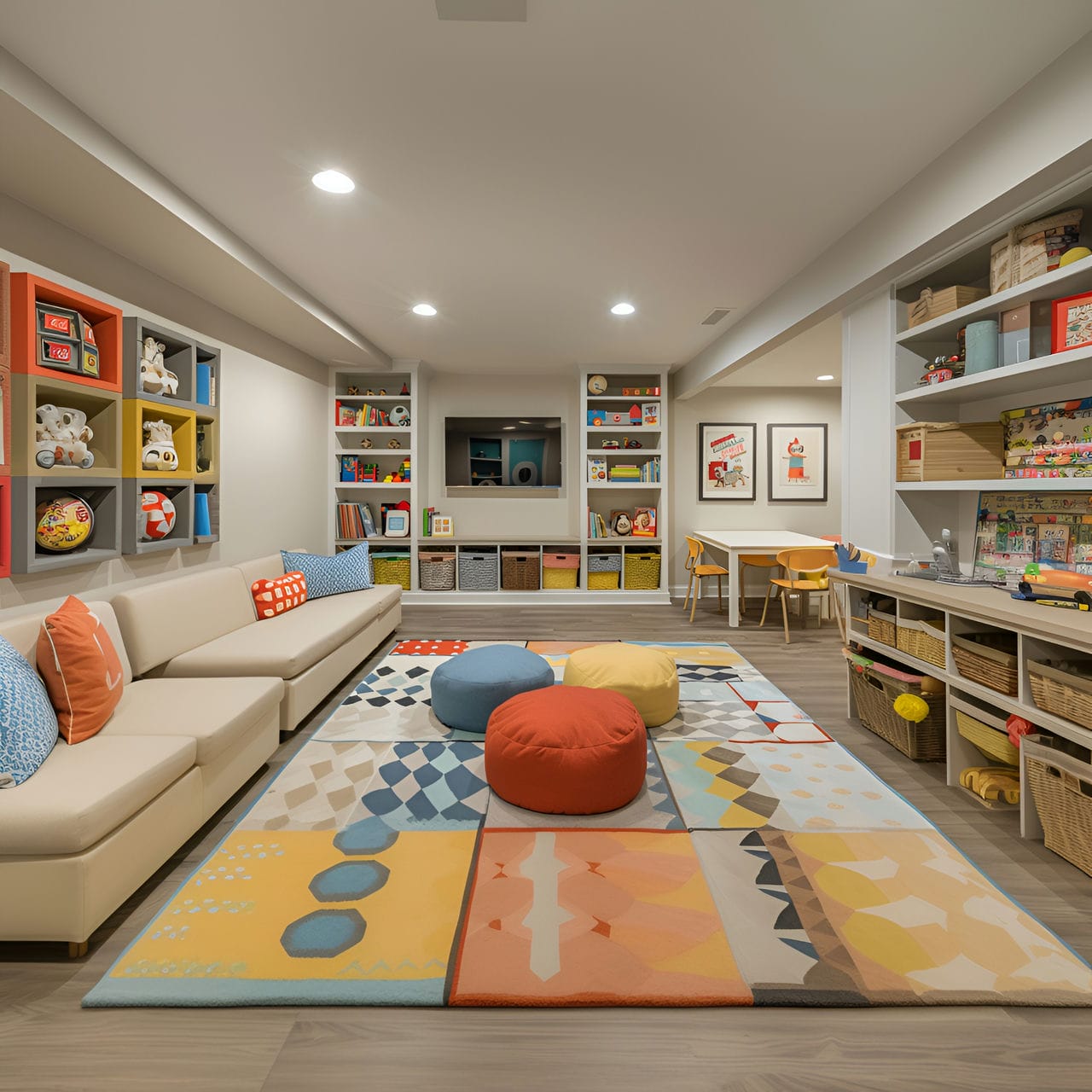
How is energy efficiency achieved in a basement?
Energy efficiency is achieved in a basement through proper insulation, air sealing, energy-efficient lighting and appliances, and a well-designed HVAC system. Firstly, proper insulation is essential for energy efficiency in a basement. Insulating the walls, floors, and ceiling helps to minimize heat transfer and maintain a consistent temperature. Insulation materials such as foam boards, fiberglass, or spray foam can effectively reduce heat loss in winter and heat gain in summer, resulting in lower energy requirements for heating and cooling. Secondly, ensuring airtightness in the basement is another key aspect of energy efficiency. Sealing gaps, cracks, and openings in the basement walls, windows, and doors prevent air leakage and drafts. Weatherstripping and caulking can seal windows and doors, while foam sealants or insulation can seal gaps around pipes, vents, and electrical outlets. Energy loss is minimized, and the HVAC system operates more efficiently. Thirdly, choosing energy-efficient lighting options can significantly contribute to energy efficiency in the basement. LED (Light Emitting Diode) bulbs are highly recommended as they consume less energy, have a longer lifespan, and produce less heat than traditional incandescent or fluorescent bulbs. Installing dimmer switches or motion sensors can optimize energy usage by allowing lights to be adjusted or automatically turned off when not in use. Fourthly, opting for energy-efficient models is essential if the basement includes refrigerators, freezers, or laundry machines. Energy Star-certified appliances are designed to consume less energy while maintaining optimal performance. These appliances typically use advanced technologies and features that reduce energy consumption, such as improved insulation, efficient compressors, and smart controls. Lastly, the heating, ventilation, and air conditioning (HVAC) system significantly affect energy efficiency. Designing the HVAC system specifically for the basement’s size and requirements ensures optimal performance and energy usage. Properly sized ductwork, regular maintenance, and programmable thermostats allow homeowners to control the temperature efficiently and avoid unnecessary greenhouse waste.
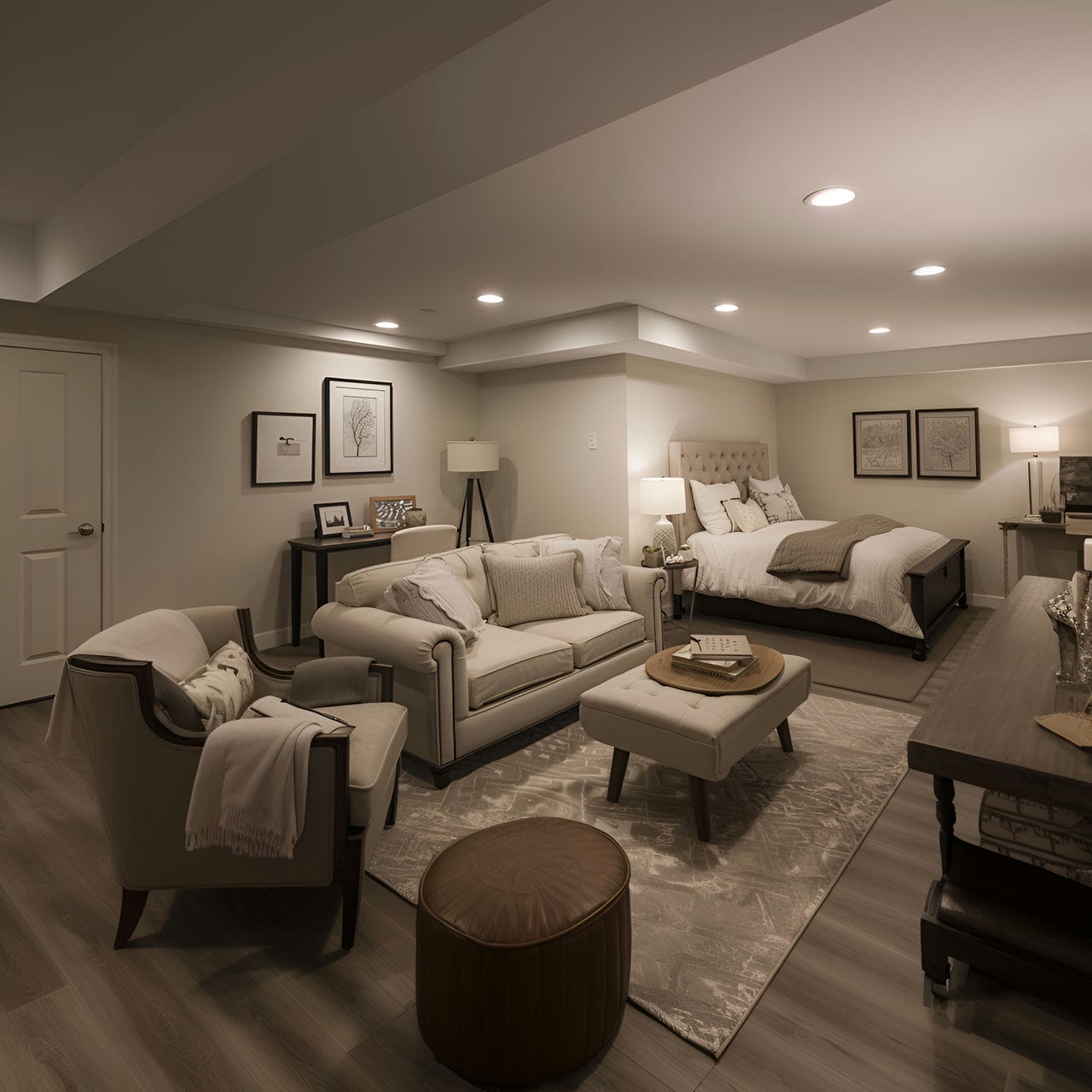
How much does it typically cost to renovate a basement?
It typically costs $10,000 (€9,100, £8,700) to $30,000 (€27,300, £26,100) or more to renovate a basement. A basic renovation that focuses on essential improvements such as insulation, drywall installation, flooring, and basic lighting can cost $10,000 (€9,100, £8,700) to $15,000 (€13,650, £13,050). This type of renovation usually involves minimal structural changes and focuses on creating a functional space. A mid-range renovation that includes additional features such as a bathroom, upgraded flooring, improved lighting fixtures, and some custom finishes can range from $15,000 (€13,650, £13,050) to $25,000 (€22,750, £21,750). This level of renovation may also involve adding or modifying walls, upgrading the electrical system, and installing a heating and cooling system. A high-end renovation with premium finishes, custom built-ins, advanced lighting, and sound systems, a full bathroom or kitchenette, and potentially structural modifications can cost $25,000 (€22,750, £21,750) to $30,000 (€27,300, £26,100) or more. This level of renovation often includes extensive customization and requires professional design and craftsmanship.
What factors affect the basement renovation?
Listed below are the factors that affect the basement renovation:
- Existing Condition: The current state of the basement, including its layout, structural integrity, and any existing issues, such as water damage or mold, will impact the renovation process. Remedying these issues can add to the overall renovation cost and timeline.
- Size and Layout: The basement’s size and layout influence the renovation’s complexity. A larger basement or one with complicated design elements may require more materials, labor, and planning, thereby increasing the overall cost and duration of the renovation.
- Desired Function: The intended use of the renovated basement, whether a living space, entertainment area, home office, or guest suite, will impact the design and features required. Different functions may necessitate specific elements, such as plumbing, electrical work, or custom installations, which can affect the renovation cost.
- Level of Finishes: The choice of finishes, such as flooring, lighting fixtures, cabinetry, and countertops, can significantly impact the cost of a basement renovation. Opting for high-end or custom finishes will be more expensive than choosing budget-friendly options.
- Building Codes and Permits: Compliance with local building codes and obtaining necessary permits is crucial for basement renovations. Factors such as egress windows, ceiling height requirements, and electrical and plumbing codes may need to be considered, potentially impacting the renovation plans and costs.
- Plumbing and Electrical Work: If the basement renovation involves adding or modifying plumbing and electrical systems, the complexity of these installations can affect the overall cost. Extensive work may be required to ensure proper connections and meet safety standards.
- Access Points: The location and accessibility of the basement can affect the renovation process. Factors such as narrow staircases, limited entry points, or the need for specialized equipment to move materials can add challenges and potentially increase costs.
- Professional Expertise: Hiring professionals such as contractors, architects, or designers can greatly impact the success and cost of a basement renovation. Their expertise and experience in navigating design challenges and coordinating the project can ensure a smoother process and potentially save costs by avoiding mistakes or rework.
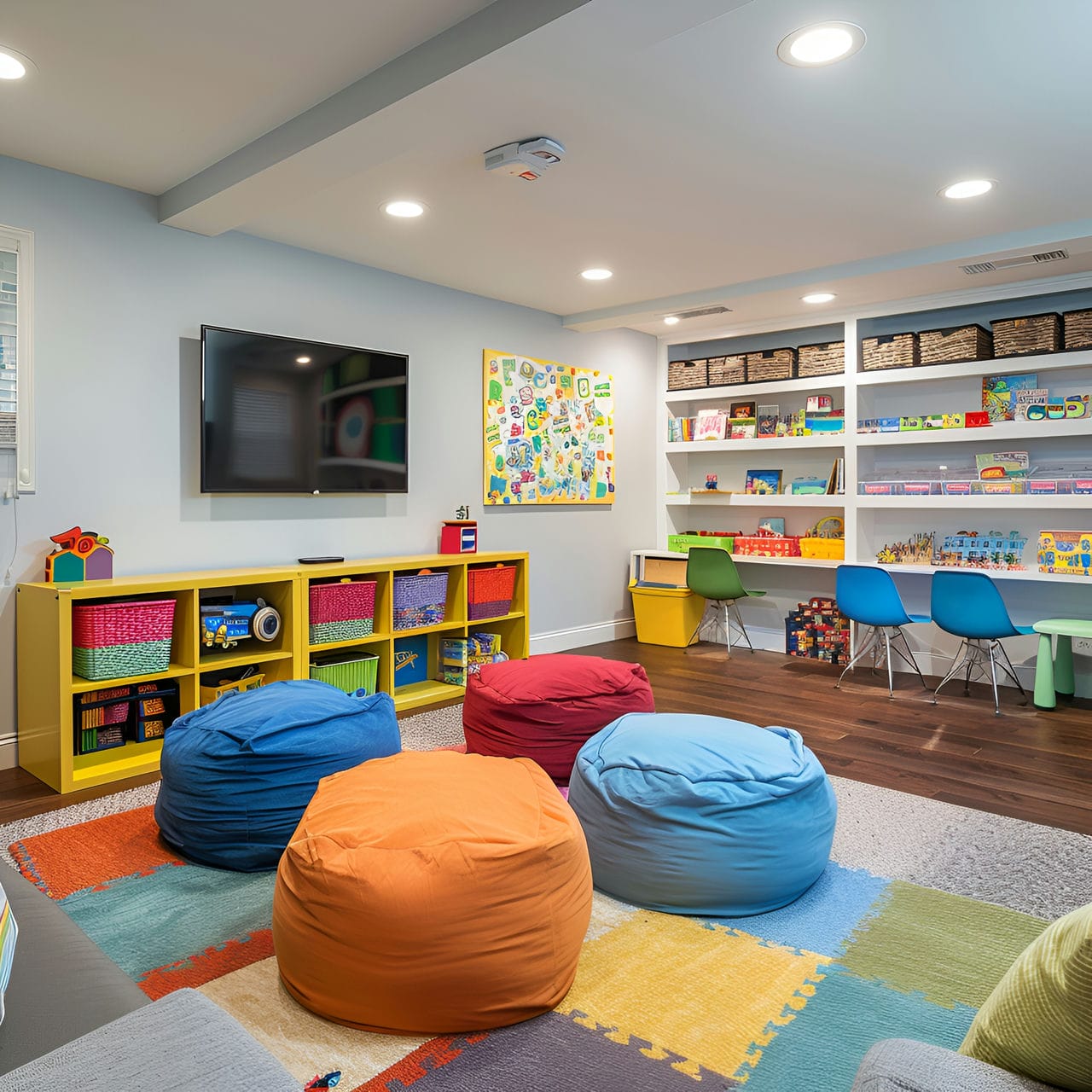
Is an architect required to renovate a basement?
No, an architect is not required to renovate a basement, but it is highly advised. An architect possesses the knowledge and expertise to assess the structural integrity of the basement and identify any potential issues that need to be addressed. They can provide valuable insights and recommendations on the best approaches to overcoming design and construction challenges, ensuring the renovation meets building codes and regulations. An architect can help homeowners optimize the functionality and aesthetics of the renovated space. They have a keen eye for design and can create customized plans that maximize the use of available space, improve natural lighting, and enhance the overall flow and comfort of the basement. Their understanding of materials, finishes, and construction techniques allows them to create a cohesive and visually appealing design.
How can an architect help you upgrade a basement?
Listed below are the ways that an architect can help an owner upgrade a basement:
- Space Planning: An architect can assess the existing layout of the basement and develop a functional and efficient space plan that optimizes the use of available area.
- Structural Modifications: If structural changes are required, an architect can provide expertise in determining which walls can be removed or altered, ensuring the structural integrity of the basement is maintained.
- Lighting and Ventilation: Architects can design effective lighting schemes, incorporating natural light sources and artificial lighting fixtures to create an inviting and well-lit basement. They can also recommend ventilation strategies to ensure proper airflow and prevent moisture issues.
- Customized Storage Solutions: Architects can design custom basement storage solutions, such as built-in shelving, cabinets, or closets, to maximize storage space and help homeowners organize their belongings.
- Interior Finishes and Materials: Architects can guide homeowners in selecting appropriate interior finishes and materials that are aesthetically pleasing, durable, and suitable for the basement environment.
- Integration of Systems: Architects can coordinate the integration of various systems, such as plumbing, electrical, and HVAC, ensuring they are properly installed and integrated into the overall design of the basement.
- Accessibility Considerations: Architects can address accessibility needs, such as incorporating ramps or wider doorways, to ensure the basement is accessible to all individuals, including those with mobility challenges.
- Permits and Building Codes: Architects are knowledgeable about local building codes and permit requirements for renovating the basement. They can help homeowners navigate the necessary approvals and ensure the renovation complies with all applicable regulations.
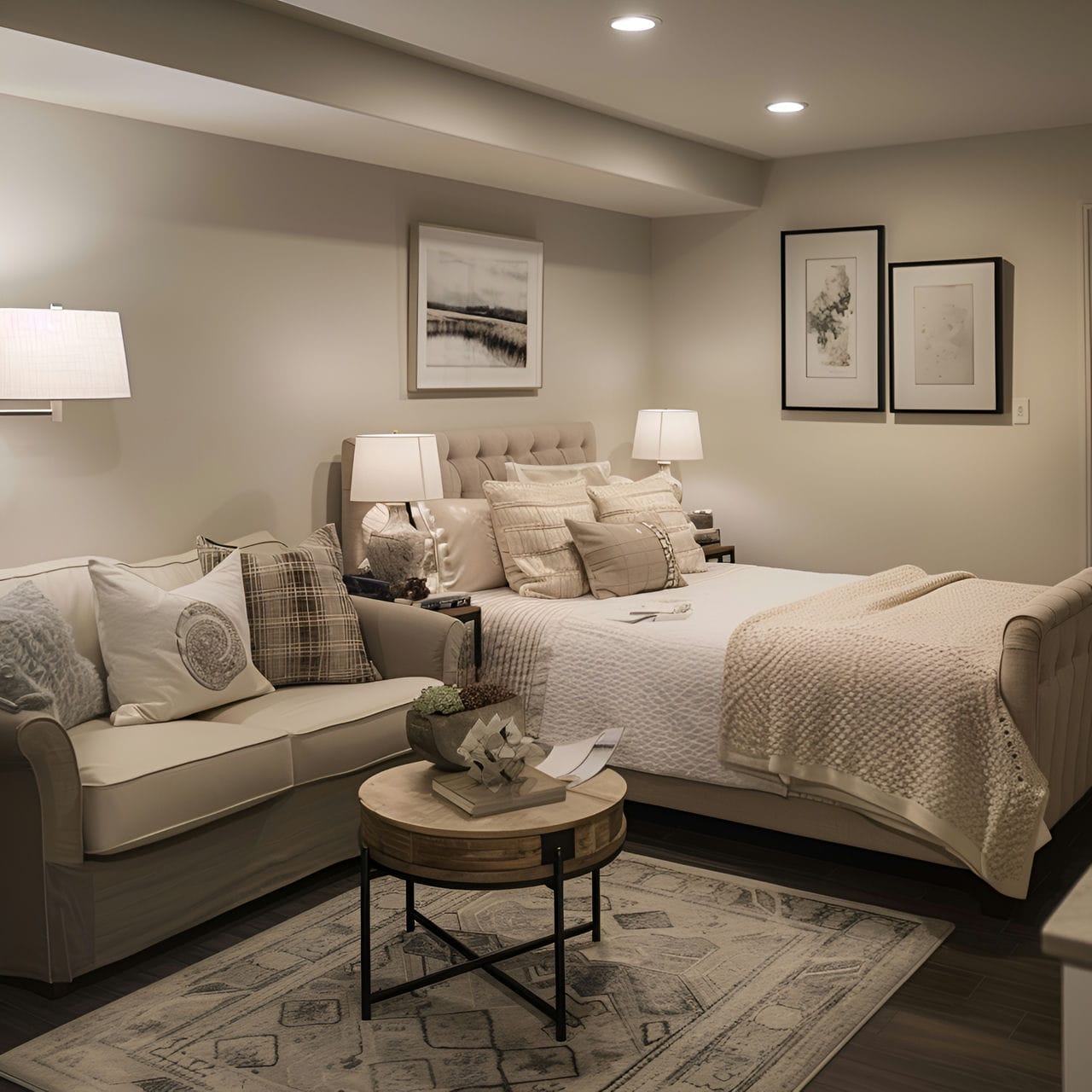
How much does it cost to hire an architect to renovate a basement?
It costs $3,500 (€3,185, £3,045) to $8,000 (€7,280, £6,960) or more to hire an architect to renovate a basement. The cost of an architect’s services for a basement renovation is typically calculated as a percentage of the total project cost. The average architectural fee ranges from 10% to 20% of the construction budget. For example, if the total renovation cost is estimated to be $35,000 (€31,850, £30,450), the architect’s fee would be between $3,500 (€3,185, £3,045) to $7,000 (€6,370, £6,090). Some architects may charge an hourly or fixed fee for specific services, such as site visits, design consultations, or drawing preparation. These additional fees should be discussed and agreed upon with the architect before the project commences. Homeowners should consult with multiple architects, discuss their project requirements, and obtain detailed cost estimates to make an informed decision that aligns with their budget and design goals.
Is it worth it to hire an architect to upgrade a basement?
Yes, it is worth it to hire an architect to upgrade a basement. An architect has specialized knowledge in creating thoughtful and innovative designs. They can optimize the use of space, enhance natural lighting, and improve the overall aesthetics of the basement. Their expertise ensures that the renovated space meets the specific needs and preferences of the homeowner. Basements often have unique structural considerations. An architect can assess the existing conditions, identify potential issues, and develop appropriate solutions. They can ensure that any structural modifications align with safety standards, preventing future problems and ensuring the long-term stability of the space.
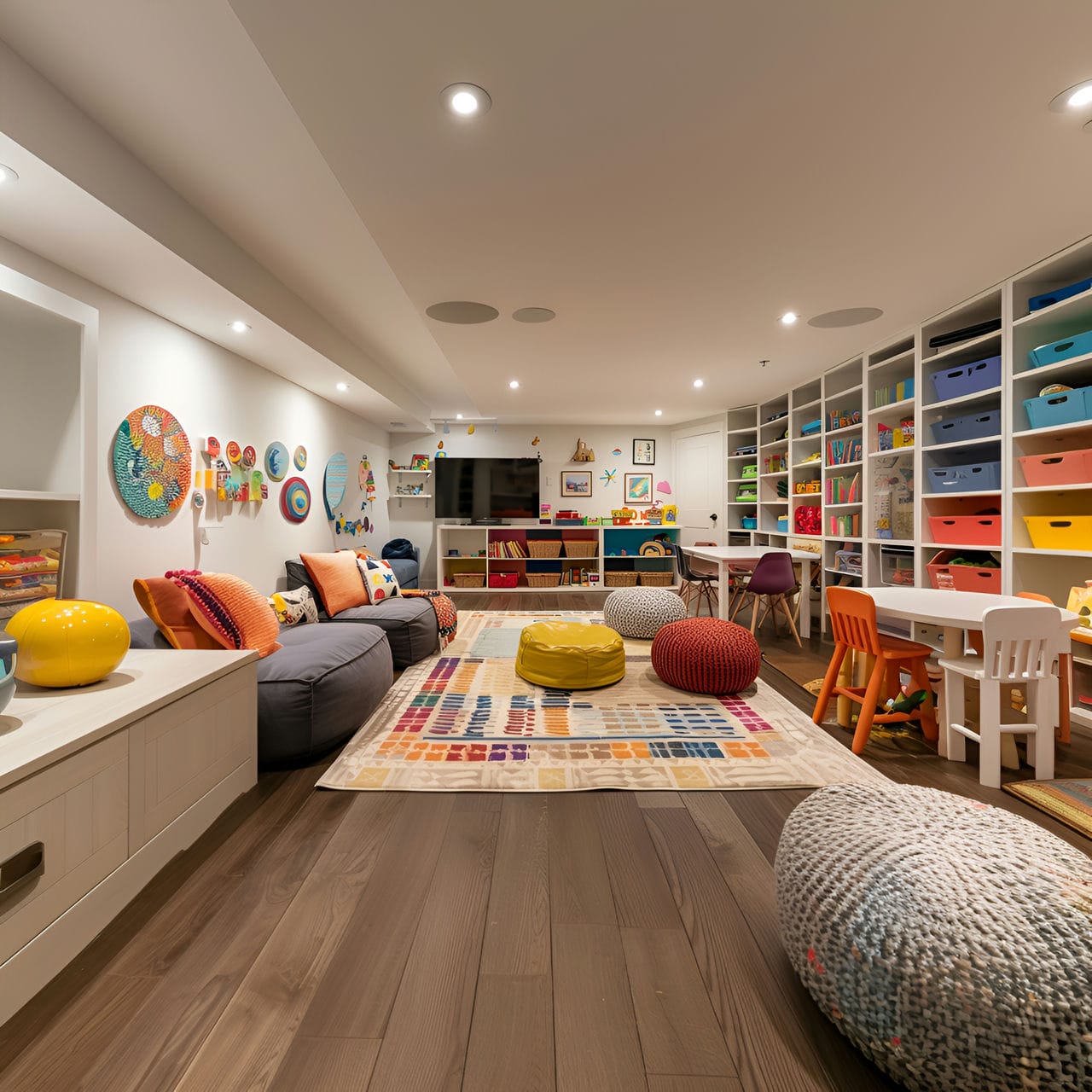
How long is needed to redecorate a basement?
4 weeks to 8 weeks is needed to redecorate the basement. The scope of the redecoration project plays a significant role in determining the duration. If the renovation involves major structural changes, such as removing walls or adding new partitions, it will likely take longer due to the additional construction work involved, but if the project primarily focuses on cosmetic updates like painting, flooring, and lighting, it could be completed more swiftly. The availability of contractors and materials can impact the timeline. If there is a high demand for contractors or if specific materials need to be ordered or customized, it may cause delays in the project. Scheduling conflicts with contractors or unexpected changes to the renovation plan can also extend the duration of the redecoration. Unforeseen issues that arise during the renovation can affect the timeline. These could include unexpected problems with the plumbing, electrical systems, or structural elements that require additional time and effort.
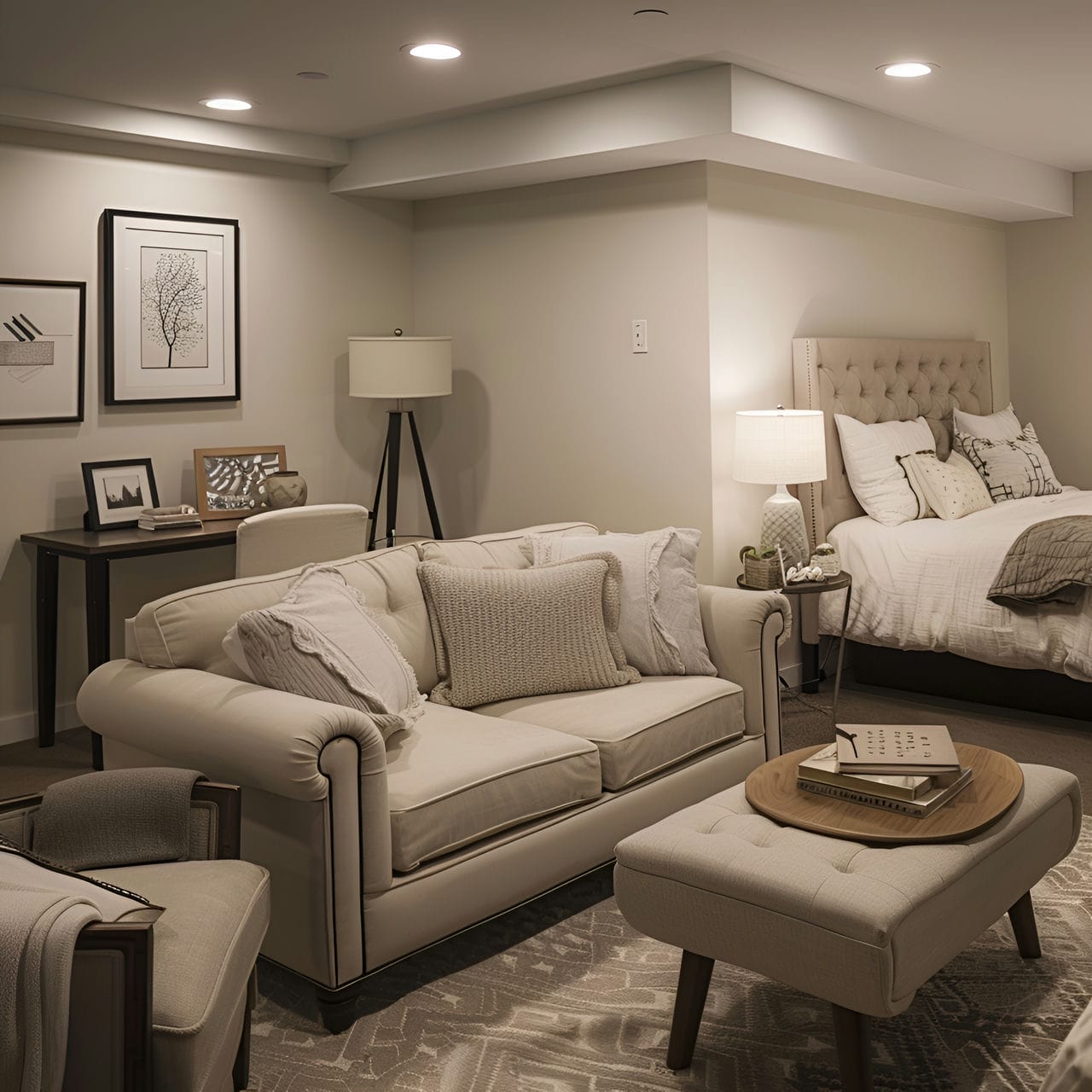
What are the struggles of the homeowner to redecorate a basement?
Listed below are the struggles of the homeowner to redecorate a basement:
- Budget constraints: Homeowners may struggle with setting a realistic budget for the basement redecoration project, as unexpected expenses can arise during renovation.
- Design decisions: Making design choices can be challenging for homeowners, especially if they are unsure about the overall aesthetic and functionality they want to achieve in the basement.
- Lack of expertise: Homeowners may not have the necessary knowledge and skills to plan and execute a basement redecoration. This can lead to difficulties in determining the most suitable materials, layout, and color schemes.
- Time management: Coordinating and managing the basement renovation project can be overwhelming for homeowners, particularly if they have other commitments or lack experience overseeing construction projects.
- Contractor selection: Finding reliable and skilled contractors can be a struggle, as homeowners may need to research and interview multiple professionals to ensure they choose the right team for their basement renovation.
- Permit and regulatory requirements: Understanding and navigating the necessary permits and building codes can be challenging for homeowners, leading to potential delays and complications of the basement renovation.
- Unforeseen issues: During the basement renovation process, unexpected problems may arise, such as hidden structural damage or plumbing issues, which can cause setbacks and additional expenses.
- Stress and decision fatigue: The process of redecorating a basement can be stressful for homeowners, as they need to make numerous decisions and deal with potential setbacks and challenges along the way. This can lead to decision fatigue and emotional strain.
